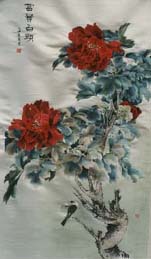Chinese Culture >> Chinese Handicrafts >> Xiang Embroidery
Introduction to Xiang Embroidery
 Xiang
embroidery is well known for its time-honored history, excellent craftsmanship
and unique style. Xiang embroidery
uses pure silk, hard satin, soft satin and nylon as its material, which is
connected with colorful silk threads.The earliest piece of Xiang embroidery was
unearthed at the No 1 Tomb of Mawangdui, Changsha City of the
Han Dynasty (206BC-AD220). The weaving technique
was almost the same as the one used in modern times, which demonstrated that
embroidery had already existed in the Han Dynasty.
In its later development, Xiang embroidery absorbed the characteristics of
traditional Chinese paintings and formed its own unique characteristics.
Absorbing the spirit of Chinese paintings, Xiang embroidery reaches a high
artistic level. Xiang embroidery crafts include valuable works of art, as well
as materials for daily use.
Xiang
embroidery is well known for its time-honored history, excellent craftsmanship
and unique style. Xiang embroidery
uses pure silk, hard satin, soft satin and nylon as its material, which is
connected with colorful silk threads.The earliest piece of Xiang embroidery was
unearthed at the No 1 Tomb of Mawangdui, Changsha City of the
Han Dynasty (206BC-AD220). The weaving technique
was almost the same as the one used in modern times, which demonstrated that
embroidery had already existed in the Han Dynasty.
In its later development, Xiang embroidery absorbed the characteristics of
traditional Chinese paintings and formed its own unique characteristics.
Absorbing the spirit of Chinese paintings, Xiang embroidery reaches a high
artistic level. Xiang embroidery crafts include valuable works of art, as well
as materials for daily use.
Xiang embroidery experienced its heyday at the end of the Qing Dynasty (1644-1911) and in the early Republic of China (early 20th century), even surpassing Su embroidery. After the founding of the People's Republic of China, Xiang embroidery was further improved and developed to a new level.
